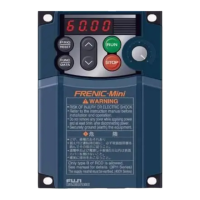4-10
4.5 Digital Output Selector
(FARFDT)
Alarm
”
”
OFF
ON
1.0 Hz
(Select motor
characteristics)
(Overload
detection level)
Electronic
Thermal
Overload
Protection
for Motor 1
(Thermal time
constant)
0
1
2
3
5
6
7
26
30
35
36
37
41
49
E31
F10
F11
F12
E34
E35
E20
E27
E32
Frequency
Detection
38
43
44
56
57
59
87
0
1
2
3
5
6
7
26
30
35
36
37
41
49
38
43
44
56
57
59
87
Current detected 2 (ID2)
Under PID control (PID-CTL)
Motor stopped due to
slow flowrate under
PID control
Motor overheat detected
by thermistor
Switched to motor 2
(SWM2)
(C1OFF)
Brake signal (BRKS)
Current Detection 2
PTC thermistor
activated
Wire Break Detection
E37
E38
H27
H26
[C1]
0
1,2
0
99
99
Note) Each number shown at switches E20 to E27 is data in normal logic system.
(Hysteresis width)
Electronic Thermal
Control for Motor
Electronic Thermal
Control for Motor
Current Detection
Low Current Detection
Inverter running (Speed > 0)
(RUN)
Frequency arrival signal (FAR)
Frequency detected (FDT)
Undervoltage detected (LU)
Inverter output limiting (IOL)
Motor overload early warning (OL)
Auto-resetting (TRY)
Service lifetime alarm (LIFE)
Inverter running 2 (RUN2)
Overload prevention control (OLP)
Current detected (ID)
Low current detected (IDL)
(ALM)
Relay Contact Output
[30A/B/C]
Transistor Output
[Y1]
[30A/B/C] (Status output contact)
[Y1] (Transistor output)
≧1000
<1000
≧1000
<1000
Auto-restarting after
momentary power failure
(IPF)
(PID-STP)
(THM)
Frequency
arrival detected
Alarm output (for
any alarm)
Terminal [C1] wire
break
Overload Early
Warning/Current
Detection/Low
Current Detection
(Timer)
(Level)
Frequency Detection
(Detection level)
(Timer)
(Level)
Current
Detection 2
(Level)
(Mode
selection)
Thermistor
Output frequency 1 (before
slip compensation)
Figure 4.4 Digital Output Signal Selector

